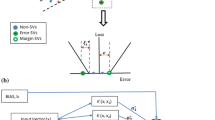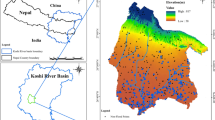Abstract
The machine learning models (MLMs), including support vector regression (SVR), multivariate adaptive regression spline (MARS), boosted regression trees (BRT), and projection pursuit regression (PPR) are compared to traditional method i.e. nonlinear regression (NLR) in regional flood frequency analysis (RFFA). In this study, the Karun and Karkheh watersheds, which is located in the southwestern of Iran, with the same climatic and physiographic conditions are considered. Fifty-four hydrometric stations with a period of 21 years (1993–2013) are selected based on the instructions of U.S. Federal Agencies Bulletin 17 B were applied for RFFA. The generalized normal (GNO) probability distribution function (PDF) is selected by the L-moment method among five PDFs, including the GNO, generalized Pareto (GP), generalized logistic (GL), generalized extreme value (GEV) and Pearson type 3 (P ІІІ) to estimate flood discharge for the expected return periods. Twenty-five predictor variables, such as physiographic, climatologic, geologic, soil and land use variables are extracted. Follow land, maximum 24-h rainfall, mean watershed slope, compactness coefficient, mean and maximum watershed elevation variables are recognized as the appropriate combination of input using gamma test (GT). The overall results indicate that the SVR, PPR, and MARS models in comparison to the NLR and BRT models have a better performance to estimate flood discharge with the expected return periods. Future, the SVR model based on radial basis function (RBF) kernel is chosen as the best model in terms of the mean of the Nash-Sutcliff coefficient (M-Ef) and the mean of relative root mean squared error (M-RMSEr) (i.e. 0.94 and 63.93, respectively) for different return periods.



Similar content being viewed by others
References
Abida H, Ellouze M (2008) Probability distribution of flood flows in Tunisia. Hydrol Earth Syst Sci 12:703–714. https://doi.org/10.5194/hess-12-703-2008
Abrahart RJ, See LM, Solomatine DP (2008) Practical hydroinformatics: computational intelligence and technological developments in water applications. Springer Science & Business Media, Berlin
Acharya N, Shrivastava NA, Panigrahi BK, Mohanty UC (2014) Development of an artificial neural network based multi-model ensemble to estimate the northeast monsoon rainfall over south peninsular India: An application of extreme learning machine. Clim Dyn 43:1303–1310. https://doi.org/10.1007/s00382-013-1942-2
Adib A, Salarijazi M, Najafpour K (2010) Evaluation of synthetic outlet runoff assessment models. J Appl Sci Environ Manag 14
Ahmad I, Waqas M, Almanjahie IM et al (2019) Regional flood frequency analysis using linear moments and partial linear moments: A case study. Appl Ecol Environ Res 17:3819–3836. https://doi.org/10.15666/aeer/1702_38193836
Ahmadi A, Han D, Karamouz M, Remesan R (2009) Input data selection for solar radiation estimation. Hydrol Process An Int J 23:2754–2764
Ahmadi A, Han D, Kakaei Lafdani E, Moridi A (2015) Input selection for long-lead precipitation prediction using large-scale climate variables: a case study. J Hydroinformatics 17:114–129
Ahn KH, Merwade V (2016) Role of watershed geomorphic characteristics on flooding in Indiana, United States. J Hydrol Eng 21:1–12. https://doi.org/10.1061/(ASCE)HE.1943-5584.0001289
Ahn KH, Palmer R (2016) Regional flood frequency analysis using spatial proximity and basin characteristics: Quantile regression vs. parameter regression technique. J Hydrol 540:515–526. https://doi.org/10.1016/j.jhydrol.2016.06.047
Apaydin H, Ozturk F, Merdun H, Aziz NM (2006) Determination of the drainage basin characteristics using vector GIS. Hydrol Res 37:129–142
Azarang F, Bajestan MS (2015) Simulating the erosion and sedimentation of Karun Alluvial River in the region of Ahvaz (Southwest of Iran). Am J Eng Res 4:233–245
Aziz K, Rahman A, Shamseldin A, Shoaib M (2013) Regional flood estimation in Australia: Application of gene expression programming and artificial neural network techniques. In Congress on Modelling and Simulation (MODSIM2013)(Adelaide, South Australia, 1-6 December 2013)
Cassalho F, Beskow S, de Mello CR et al (2018) At-site flood frequency analysis coupled with multiparameter probability distributions. Water Resour Manag 32:285–300
Chebana F, Charron C, Ouarda TBMJ, Martel B (2014) Regional Frequency Analysis at Ungauged Sites with the Generalized Additive Model. J Hydrometeorol 15:2418–2428. https://doi.org/10.1175/JHM-D-14-0060.1
Daniell TM (1991) Neural networks. Applications in hydrology and water resources engineering. In: National Conference Publication- Institute of Engineers. Australia
Deka PC (2014) Support vector machine applications in the field of hydrology: a review. Appl Soft Comput 19:372–386
Deo RC, Şahin M (2015) Application of the extreme learning machine algorithm for the prediction of monthly Effective Drought Index in eastern Australia. Atmos Res 153:512–525. https://doi.org/10.1016/j.atmosres.2014.10.016
Deo RC, Samui P, Kim D (2016) Estimation of monthly evaporative loss using relevance vector machine, extreme learning machine and multivariate adaptive regression spline models. Stoch Environ Res Risk Assess 30:1769–1784. https://doi.org/10.1007/s00477-015-1153-y
Drissia TK, Jothiprakash V, Anitha AB (2019) Flood Frequency Analysis Using L Moments: a Comparison between At-Site and Regional Approach. Water Resour Manag 33:1013–1037. https://doi.org/10.1007/s11269-018-2162-7
Durocher M, Chebana F, Ouarda TBMJ (2015) A Nonlinear Approach to Regional Flood Frequency Analysis Using Projection Pursuit Regression. J Hydrometeorol 16:1561–1574. https://doi.org/10.1175/JHM-D-14-0227.1
Elith J, Leathwick JR, Hastie T (2008) A working guide to boosted regression trees. J Anim Ecol 77:802–813. https://doi.org/10.1111/j.1365-2656.2008.01390.x
EM-DAT (2020) The OFDA/CRED International Disaster Database, viewed 17 May 2020, from https://www.emdat.be/database
Fitzpatrick FA (1998) Revised methods for characterizing stream habitat in the National Water-Quality Assessment Program. US Department of the Interior, US Geological Survey
Friedman JH (1991) Multivariate Adaptive Regression Splines. Ann Stat 19:1–67
Friedman JH, Grosse E, Stuetzle W (1983) Multidimensional additive spline approximation. SIAM J Sci Stat Comput 4:291–301
Garosi Y, Sheklabadi M, Pourghasemi HR et al (2018) Comparison of differences in resolution and sources of controlling factors for gully erosion susceptibility mapping. Geoderma 330:65–78
Ghaderi K, Motamedvaziri B, Vafakhah M, Dehghani AA (2019) Regional flood frequency modeling: a comparative study among several data driven models. Arab J Geosci 12(18):588
Gizaw MS (2017) Global warming impacts on hydrologic extremes. Ph.D. Dissertation, University of Alberta. https://doi.org/10.7939/R3GT5FT2G
Gizaw MS, Gan TY (2016) Regional Flood Frequency Analysis using Support Vector Regression under historical and future climate. J Hydrol 538:387–398. https://doi.org/10.1016/j.jhydrol.2016.04.041
Griffis VW, Stedinger JR (2007) Evolution of Flood Frequency Analysis with Bulletin 17:283–297
Haddad K, Rahman A, Ling F (2015) Regional flood frequency analysis method for Tasmania, Australia: a case study on the comparison of fixed region and region-of-influence approaches. Hydrol Sci J 60:2086–2101. https://doi.org/10.1080/02626667.2014.950583
Hailegeorgis TT, Alfredsen K (2017) Regional flood frequency analysis and prediction in ungauged basins including estimation of major uncertainties for mid-Norway. J Hydrol Reg Stud 9:104–126. https://doi.org/10.1016/j.ejrh.2016.11.004
Hajian F, Dykes AP, Cavanagh S (2019) Assessment of the flood hazard arising from land use change in a forested catchment in northern Iran. J Flood Risk Manag 12:1–16. https://doi.org/10.1111/jfr3.12481
Hishinuma S, Takeuchi K, Magome J (2014) Challenges of hydrological analysis for water resource development in semi-arid mountainous regions: case study in Iran. Hydrol Sci J 59:1718–1737
Hosking JRM, Wallis JR (1993) Some statistics useful in regional frequency analysis. Water Resour Res 29:271–281. https://doi.org/10.1029/92WR01980
Hussain Z, Pasha GR (2009) Regional flood frequency analysis of the seven sites of Punjab, Pakistan, using L-moments. Water Resour Manag 23:1917–1933. https://doi.org/10.1007/s11269-008-9360-7
Jabbarian Amiri B, Baheri B, Fohrer N, Adamowski JF (2019) Regionalization of flood magnitudes using the ecological attributes of watersheds. Geocarto Int 6049:. https://doi.org/10.1080/10106049.2018.1552321
Kar KK, Yang S-K, Lee J-H, Khadim FK (2017) Regional frequency analysis for consecutive hour rainfall using L-moments approach in Jeju Island, Korea. Geoenvironmental Disasters 4:18. https://doi.org/10.1186/s40677-017-0082-0
Kisi O, Parmar KS (2016) Application of least square support vector machine and multivariate adaptive regression spline models in long term prediction of river water pollution. J Hydrol 534:104–112. https://doi.org/10.1016/j.jhydrol.2015.12.014
Krause P, Boyle DP, Bäse F (2005) Comparison of different efficiency criteria for hydrological model assessment. Adv Geosci 5:89–97. https://doi.org/10.5194/adgeo-5-89-2005
Lee S, Kim J-C, Jung H-S et al (2017) Spatial prediction of flood susceptibility using random-forest and boosted-tree models in Seoul metropolitan city, Korea. Geomatics. Nat Hazards Risk 0:1–19. https://doi.org/10.1080/19475705.2017.1308971
Li H, Zhang J, Sun J, Wang J (2017) A visual analytics approach for flood risk analysis and decision-making in cultural heritage. J Vis Lang Comput 0:1–11. https://doi.org/10.1016/j.jvlc.2017.05.001
Marshall MR, Francis OJ, Frogbrook ZL et al (2009) The impact of upland land management on flooding: results from an improved pasture hillslope. Hydrol Process 23:464–475. https://doi.org/10.1002/hyp.7157
McGuire KJ, McDonnell JJ, Weiler M et al (2005) The role of topography on catchment-scale water residence time. Water Resour Res 41:1–14. https://doi.org/10.1029/2004WR003657
Moghaddamnia A, Ghafari M, Piri J, Han D (2009) Evaporation estimation using support vector machines technique. Int J Eng Appl Sci 5:415–423
Moriasi DN, Arnold JG, Van Liew MW et al (2007) Model evaluation guidelines for systematic quantification of accuracy in watershed simulations. Trans ASABE 50:885–900. https://doi.org/10.1007/s11269-015-1114-8
Naghibi SA, Pourghasemi HR (2015) A comparative assessment between three machine learning models and their performance comparison by bivariate and multivariate statistical methods in groundwater potential mapping. Water Resour Manag 29:5217–5236. https://doi.org/10.1007/s11269-015-1114-8
Nash JE, Sutcliffe JV (1970) River flow forecasting through conceptual models part I - A discussion of principles. J Hydrol 10:282–290. https://doi.org/10.1016/0022-1694(70)90255-6
Noto LV, La Loggia G (2009) Use of L-moments approach for regional flood frequency analysis in Sicily, Italy. Water Resour Manag 23:2207–2229
Nourani V, Andalib G, Dąbrowska D (2017a) Conjunction of wavelet transform and SOM-mutual information data pre-processing approach for AI-based Multi-Station nitrate modeling of watersheds. J Hydrol 548:170–183. https://doi.org/10.1016/j.jhydrol.2017.03.002
Nourani V, Andalib G, Sadikoglu F (2017b) Multi-station streamflow forecasting using wavelet denoising and artificial intelligence models. Procedia Comput Sci 120:617–624. https://doi.org/10.1016/j.procs.2017.11.287
Nourani V, Roushangar K, Andalib G (2018) An inverse method for watershed change detection using hybrid conceptual and artificial intelligence approaches. J Hydrol 562:371–384. https://doi.org/10.1016/j.jhydrol.2018.05.018
Persson C, Bacher P, Shiga T, Madsen H (2017) Multi-site solar power forecasting using gradient boosted regression trees. Sol Energy 150:423–436
Pourghasemi HR, Rossi M (2016) Landslide susceptibility modeling in a landslide prone area in Mazandarn Province, north of Iran: a comparison between GLM, GAM, MARS, and M-AHP methods. Theor Appl Climatol 1–25. https://doi.org/10.1007/s00704-016-1919-2
Price K, Jackson CR, Parker AJ et al (2011) Effects of watershed land use and geomorphology on stream low flows during severe drought conditions in the southern Blue Ridge Mountains, Georgia and North Carolina, United States. Water Resour Res 47:101–107. https://doi.org/10.1029/2010WR009340
Rahman A, Charron C, Ouarda TBMJ, Chebana F (2018) Development of regional flood frequency analysis techniques using generalized additive models for Australia. Stoch Environ Res risk Assess 32:123–139
Sadegh M, Mahjouri N, Kerachian R (2010) Optimal Inter-Basin Water Allocation Using Crisp and Fuzzy Shapley Games. Water Resour Manag 24:2291–2310. https://doi.org/10.1007/s11269-009-9552-9
Saf B (2009) Regional flood frequency analysis using L-moments for the West Mediterranean region of Turkey. Water Resour Manag 23:531–551
Seckin N (2011) Modeling flood discharge at ungauged sites across Turkey using neuro-fuzzy and neural networks. J Hydroinform 13:842–849
Sharifi Garmdareh E, Vafakhah M, Eslamian SS (2018) Regional flood frequency analysis using support vector regression in arid and semi-arid regions of Iran. Hydrol Sci J 63:426–440. https://doi.org/10.1080/02626667.2018.1432056
Shu C, Ouarda TBMJ (2007) Flood frequency analysis at ungauged sites using artificial neural networks in canonical correlation analysis physiographic space. Water Resour Res 43:1–12. https://doi.org/10.1029/2006WR005142
Singh PR, Gan TY (2000) Retrieval of snow water equivalent using passive microwave brightness temperature data. Remote Sens Environ 74:275–286
Stefánsson A, Končar N, Jones AJ (1997) A note on the gamma test. Neural Comput Appl 5:131–133. https://doi.org/10.1007/BF01413858
Vafakhah M (2012) Application of artificial neural networks and adaptive neuro-fuzzy inference system models to short-term streamflow forecasting. Can J Civ Eng 414:402–414. https://doi.org/10.1139/L2012-011
Vafakhah M, Bozchaloei SK (2019) Regional analysis of flow duration curves through support vector regression. Water Resour Manag 34:283–294
Warner GS, García-Martinó AR, Scatena FN, Civco DL (2003) Watershed characterization by GIS for low flow prediction. GIS water Resour watershed Manag 101–107
Wittenberg H (1999) Baseflow recession and recharge as nonlinear storage processes. Hydrol Process 13:715–726
Yilmaz I, Kaynar O (2011) Multiple regression, ANN (RBF, MLP) and ANFIS models for prediction of swell potential of clayey soils. Expert Syst Appl 38:5958–5966
Zhang Q, Gu X, Singh VP et al (2017) Timing of floods in southeastern China: Seasonal properties and potential causes. J Hydrol 552:732–744. https://doi.org/10.1016/j.jhydrol.2017.07.039
Author information
Authors and Affiliations
Corresponding author
Additional information
Publisher's Note
Springer Nature remains neutral with regard to jurisdictional claims in published maps and institutional affiliations.
Rights and permissions
About this article
Cite this article
Allahbakhshian-Farsani, P., Vafakhah, M., Khosravi-Farsani, H. et al. Regional Flood Frequency Analysis Through Some Machine Learning Models in Semi-arid Regions. Water Resour Manage 34, 2887–2909 (2020). https://doi.org/10.1007/s11269-020-02589-2
Received:
Accepted:
Published:
Issue Date:
DOI: https://doi.org/10.1007/s11269-020-02589-2




